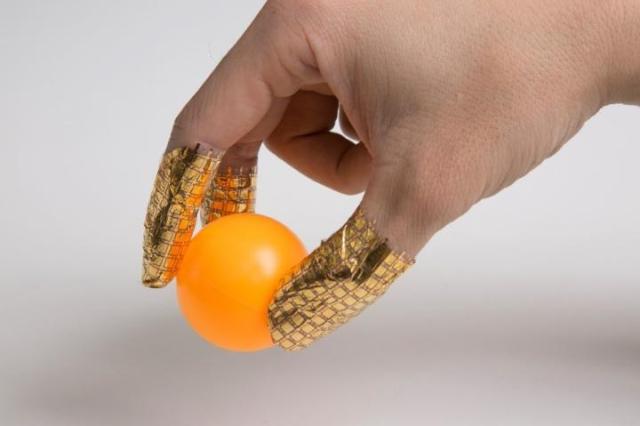Jan 28 2016
Teams from America and Japan have developed a bendable, sensitive and transparent pressure sensor, which could enable healthcare practitioners to use pressure-sensitive rubber gloves to conduct physical screening for breast cancer.
 The pressure sensors wrap around and conform to the shape of the fingers while still accurately measuring pressure distribution. (CREDIT: 2016 Someya Laboratory)
The pressure sensors wrap around and conform to the shape of the fingers while still accurately measuring pressure distribution. (CREDIT: 2016 Someya Laboratory)
Pressure sensors have sufficient flexibility to fit to soft surfaces like the human skin, despite this, conventional pressure sensors are unable to accurately measure the changes in pressure when they are wrinkled or twisted. This means the pressure sensors are unsuitable for use on moving and complex surfaces. Another disadvantage is that the sensors cannot be easily reduced to below 100 µm thickness due to restrictions in current production methods.
The issues were addressed by an international research team headed by Dr. Sungwon Lee and Professor Takao Someya of the University of Tokyo's Graduate School of Engineering. The team created a nanofiber-type pressure sensor to measure pressure distribution of rounded surfaces - like an inflated balloon - and maintain the sensing accuracy, even if the rounded surface is bent over a radius of 80 µm, which is equal to twice the width of human hair. The pressure sensor is capable of simultaneously measuring the pressure in 144 locations, and has a thickness of roughly 8 µm.
This equipment used in this research includes a pressure sensitive nanofiber structure, electronic switches manufactured from oxygen and carbon based organic materials, and organic transistors. Nanofibers with a diameter ranging from 300 to 700 nm were developed by adding graphene and carbon nanotubes to an elastic polymer. The nanofibers were then twisted together to develop a light, thin and transparent porous structure.
We've also tested the performance of our pressure sensor with an artificial blood vessel and found that it could detect small pressure changes and speed of pressure propagation, Flexible electronics have great potential for implantable and wearable devices. I realized that many groups are developing flexible sensors that can measure pressure but none of them are suitable for measuring real objects since they are sensitive to distortion. That was my main motivation and I think we have proposed an effective solution to this problem.
Dr Sungwon Lee, University of Tokyo